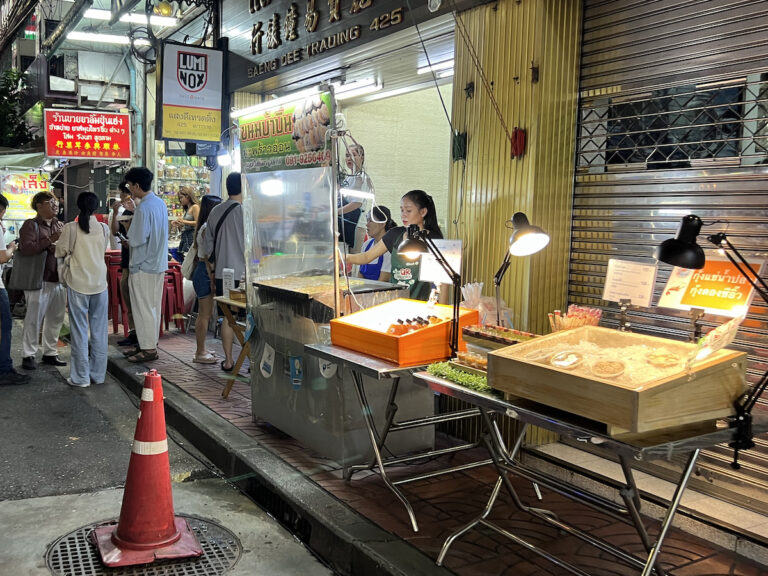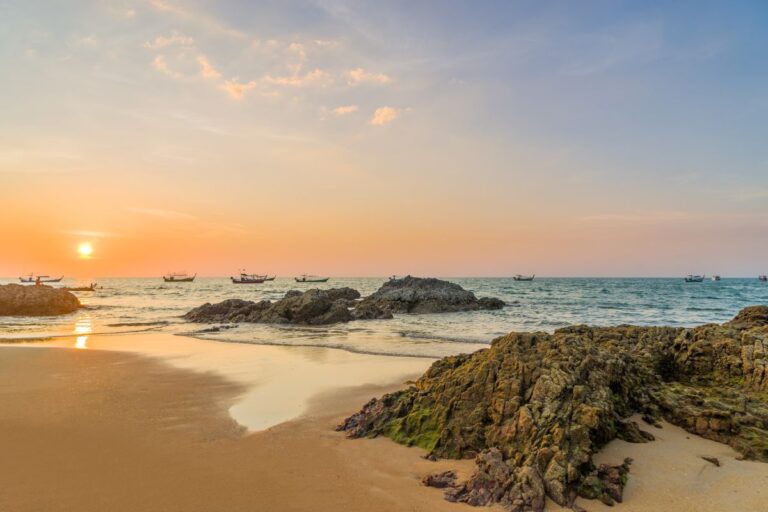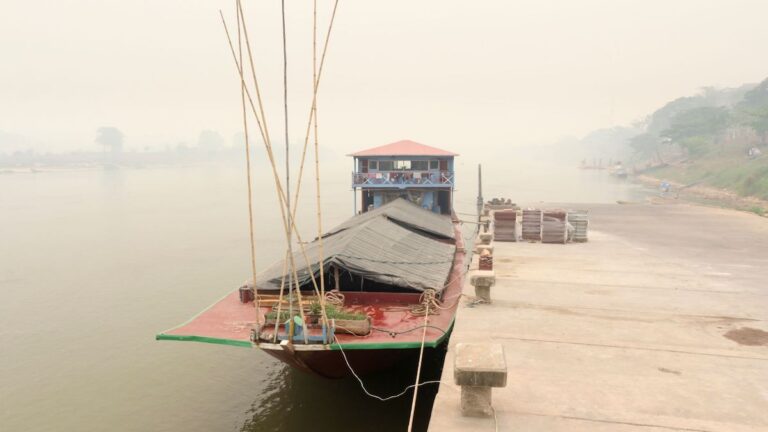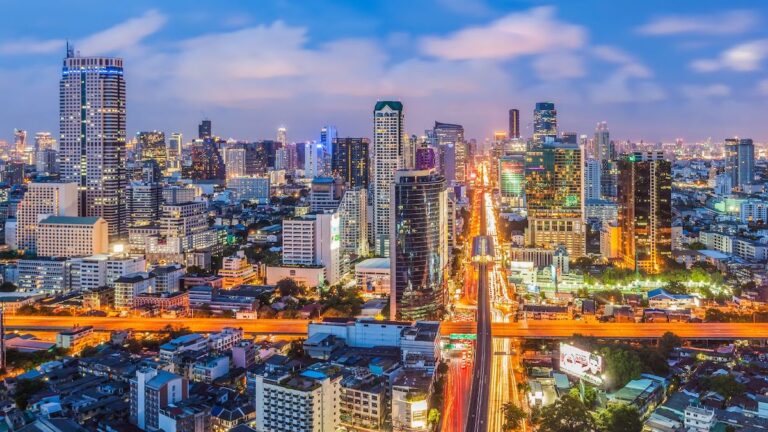National Museum of Royal Barges
Address: 80 1 Arun Amarin Rd, Arun Amarin, Bangkok Noi, Bangkok 10700, Thailand
Open Hours: daily from – 9 am – 5 pm
Tickets: The museum entry ticket costs 100 baht, and there is an additional charge of 100 baht for any type of camera.
Nestled in the heart of Bangkok, this unusual museum is home to a fascinating collection of eight intricately crafted royal barges. They are occasionally used in splendid royal processions along the Chao Phraya River. Join us on a journey through time as we explore the history, cultural significance, craftsmanship, and regal legacy of these vessels.
The History of the Royal Barges Processions
Having taken place for almost 700 years, Bangkok’s Royal Barge Procession is a ritual with massive royal, religious, and cultural weight. The event is not an annual occasion and only occurs to coincide with other significant religious and imperial events.
In fact, during the reign of the current monarch, King Bhumibol Adulyadej, who has been in power for more than 60 years, the procession has taken place a mere 16 times. You really need to plan in advance to get a taste of this momentous event. However, the beautiful and ornately decorated barges are always on display at the Royal Barges Museum, across the river from the Grand Palace.
The procession’s origins probably lie in the Ayutthaya period during the 14th century, when hundreds or even thousands of boats were said to have sailed along the Chao Phraya River to the rhythmic beating of drums. In those days the river was the main course of transport and elegantly embellished barges were a sign of wealth and importance. It was seen as being of great consequence to maintain large quotas of boats in the imminence of war and unrest.
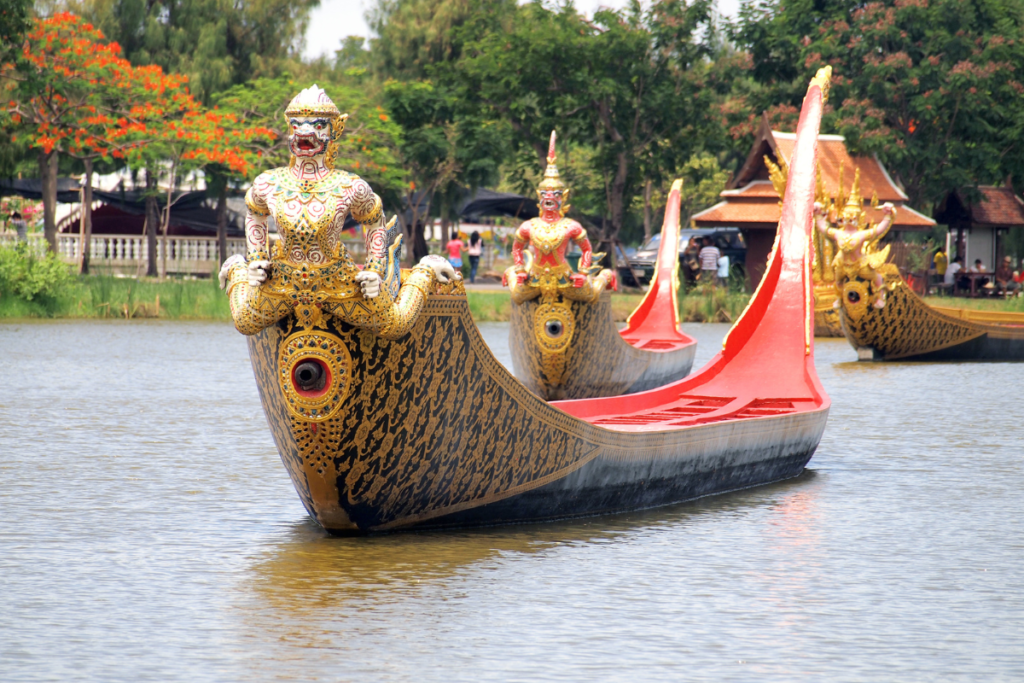
In the 18th century, the Burmese invaded the country and destroyed hundreds of barges but shortly afterward, the new king sought to restore some of the old splendor of Ayutthaya and a new fleet was built, of which more than 100 barges were used to carry Buddha images to the new capital of Bangkok. Until the 1930s, the processions came to pass intermittently but after the dissolution of the absolute monarchy, they stopped entirely until 1957, when Thailand celebrated 25 centuries of the Buddhist era.
The organization of the procession was first regulated during the reign of Rama V and is divided into two formations. The Major Formation is used for only the most momentous occasions while the Minor Formation is used at other times. More than 50 oarsmen and other attendants row gold and silver oars in unison, bringing them high at the end of each stroke. The rhythm is kept by the tapping of a silver spear on the deck and boat songs are chanted by all onboard.
The newest barge to be constructed was the Narai Song Suban King Rama IX, built in 1994. A figurehead of the god, Narai, riding on his heavenly vehicle, the garuda, harks back to a barge that was built during the third reign. These days this magnificent royal barge is joined by 51 others as they travel down the Chao Phraya River, beginning at Khet Dusit’s Wasukri Royal Landing Place and landing at Wat Arun (Temple of the Dawn). The fleets pass by the Temple of the Emerald Buddha, the Grand Palace, and Wat Po on the way.
Another procession to take place was in June 2006 and was staged in celebration of the 60th anniversary of the king’s reign. A crew of over 2,000 manned the barges and monarchs and representatives from around the world were invited as special guests. Before the event, two rehearsals took place on the lawns on the banks of the river. These were accompanied by light and sound shows and quickly sold out.
Though held at the height of the monsoon, the heavy rains could not deter the crowds, who were rewarded with the rare spectacle of the splendid and colorful fleet sailing over three kilometers. Restaurants and specially provided seating areas along the river were crammed full of people trying to catch a glimpse of this rare event.
On the 5th of November 2007, a grand Royal Barge Procession was held at Wat Arun to mark the King’s 80th Birthday, followed by another procession on the 9th of November 2012 for the Royal Kathin Ceremony.
The most recent procession, involving 52 barges, took place on the 12th of December 2019 to honor Thailand’s new monarch, King Maha Vajiralongkorn.
Barges Exhibition in the Museum
In the absence of any majestic processions happening during your visit, you can view eight of the barges at the Royal Barge Museum, which is located across the river from the Grand Palace. Each barge on display has been carved from enormous pieces of teak and the prows are embellished with gilded mythical creatures and shimmering cut glass ornament. The Suppanahong (Golden Swan) barge is the most eminent of all vessels, with its vast golden swan figurehead, and a collection of oars and other memorabilia of past processions is displayed alongside it.
- Royal Barge Narai Song Suban – Rama IX
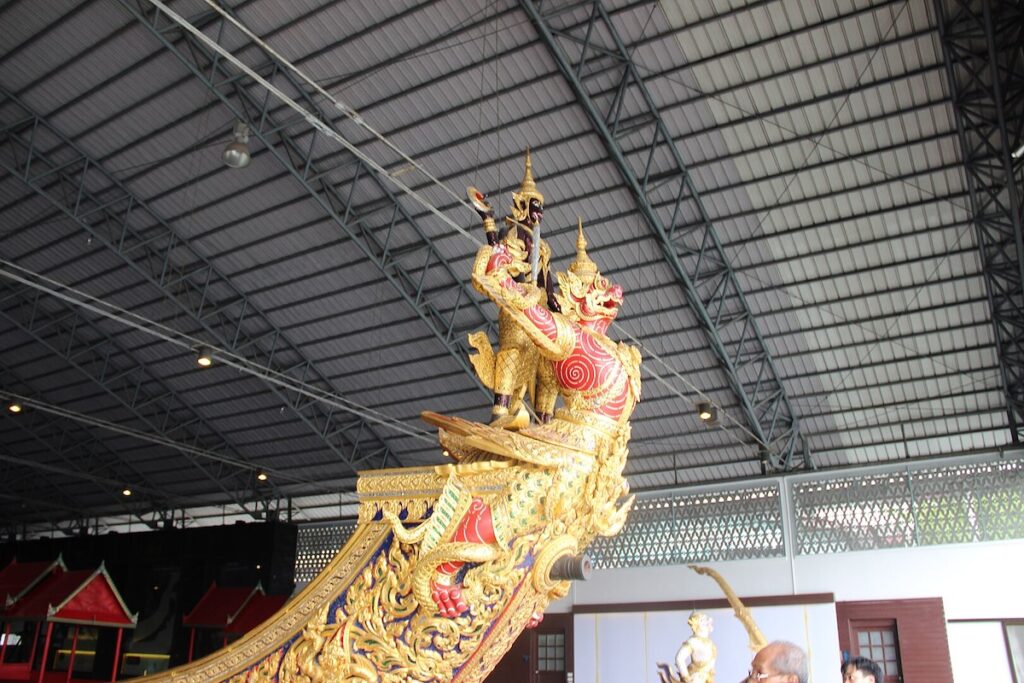
The barge showcases a magnificent figurehead of the god Vishnu, mounted on a garuda, which is gripping a Naga (a legendary creature with the appearance of a great snake). Beneath the Garuda, there is a porthole for a cannon. The barge is adorned with golden lacquer and glass ornaments, adding to its regal beauty. It measures 44.30 meters in length, 3.20 meters at the beam width, and has a hull depth of 1.10 centimeters.
- Royal Barge Suphannahong
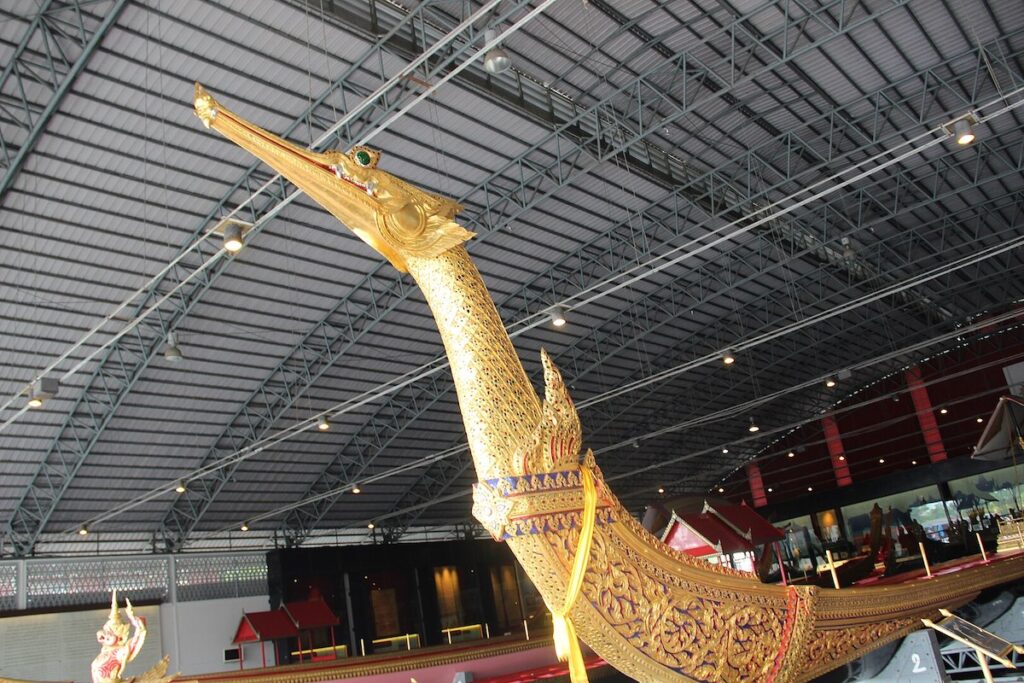
The barge features a stunning gold, royal swan-shaped prow adorned with glass ornaments. It boasts an impressive length of 46.15 meters, a width of 3.17 meters, a hull depth of 94 cm (37 inches), and a draught of 41 cm.
- Royal Barge Anechatbhuchong

This barge features exquisite carvings and gilding in a pattern of small nagas. Its hull is painted pink on the outside and red on the inside, adding to its magical allure.
It measures 45.67 meters in length, 2.91 meters in width, and has a hull depth of 91 centimeters.
- Ekachai Hern How Barge
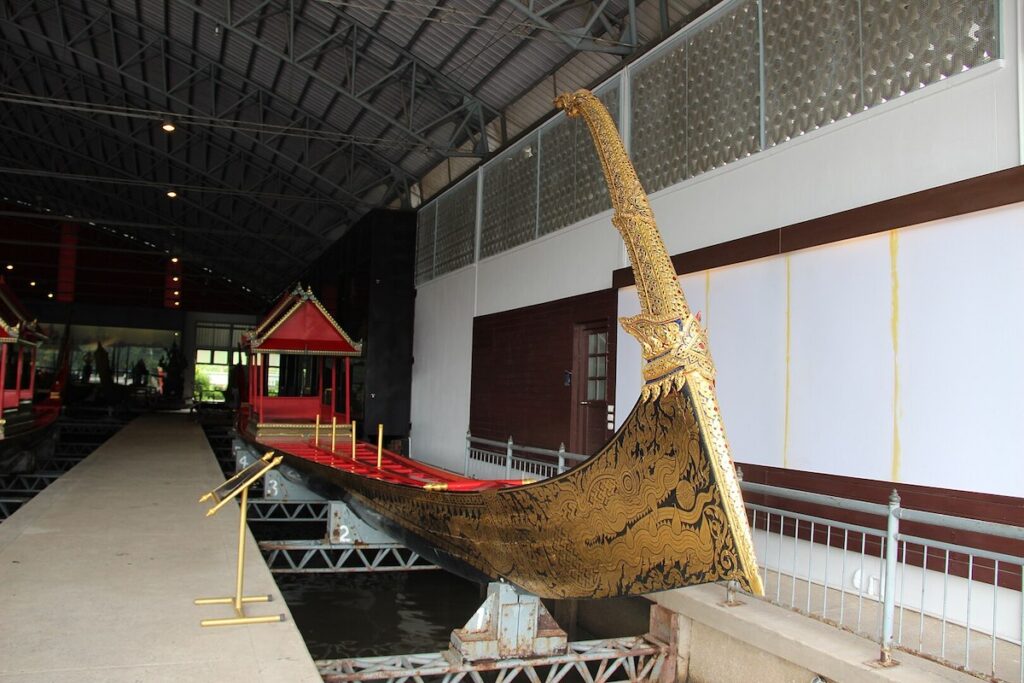
The barge is adorned with a figurehead of Hera, featuring Naga-headed Dragons, beautifully decorated with golden lacquer.
It measures 29.76 meters in length, 2.06 meters at the beam width, and has a hull depth of 60 centimeters.
- Royal Barge Anantanagaraj
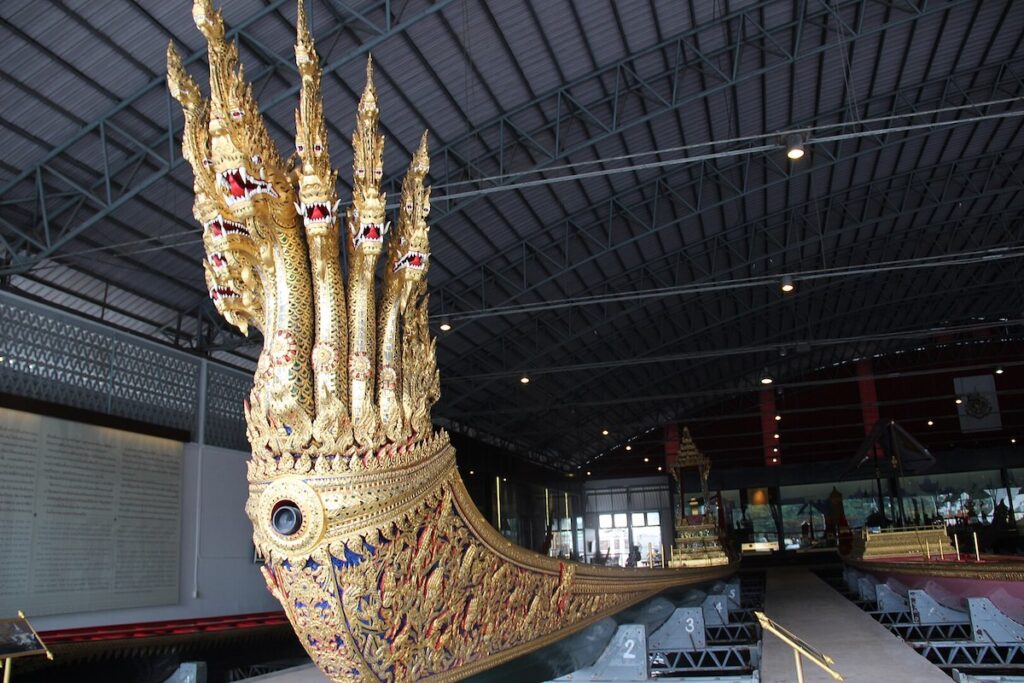
The barge boasts a majestic prow in the shape of seven-headed nagas. It is adorned with golden lacquer and intricate glass ornaments, adding to its grandeur. The hull is painted green on the outside and red on the inside, creating a striking contrast.
In terms of measurements, it spans 44.85 meters in length, 3.17 meters at the beam width, and has a hull depth of 94 centimeters.
- Krabi Prab Muang Marn Barge
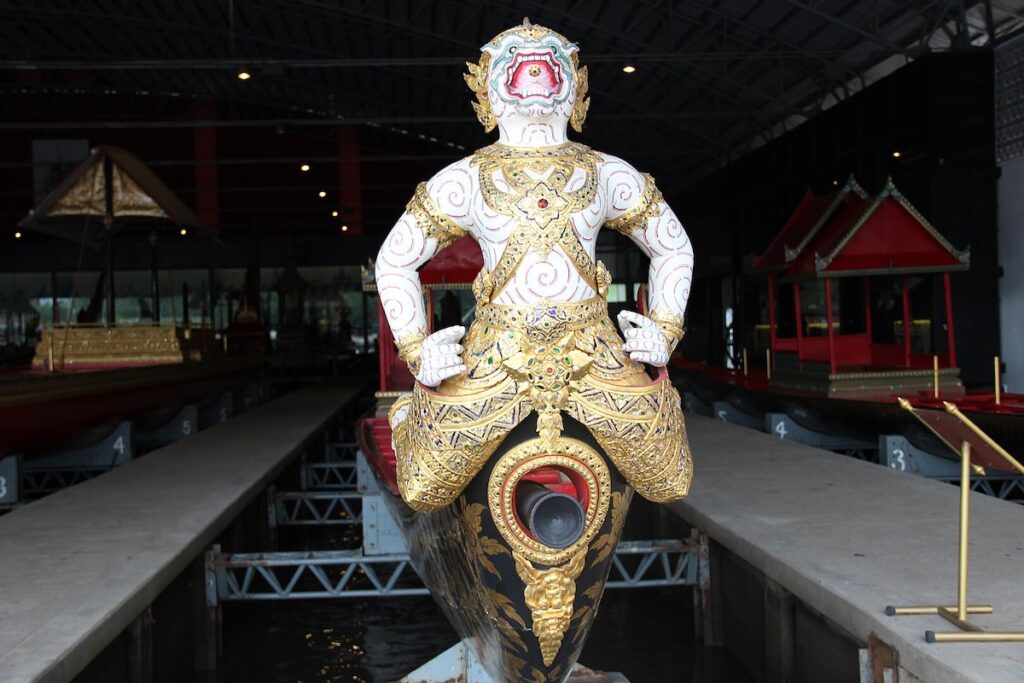
The barge showcases an impressive figurehead of an uncrowned monkey warrior with a white body resembling Hanuman. It is beautifully adorned with golden lacquer and delicate glass decorations, adding to its allure.
In terms of size, this barge measures 28.85 meters in length, 2.10 meters at the beam width, and has a hull depth of 56 centimeters.
- Asura Vayuphak Barge

The barge features a striking figurehead of an ogre-faced bird, with an indigo-colored face, hands, and feet, and a purple front, while the back is adorned in green. The hull is painted black on the outside, giving it a bold appearance.
This barge spans 31 meters in length, 2.03 meters at the beam width, and has a hull depth of 62 centimeters.
- Krut Hern Het Barge
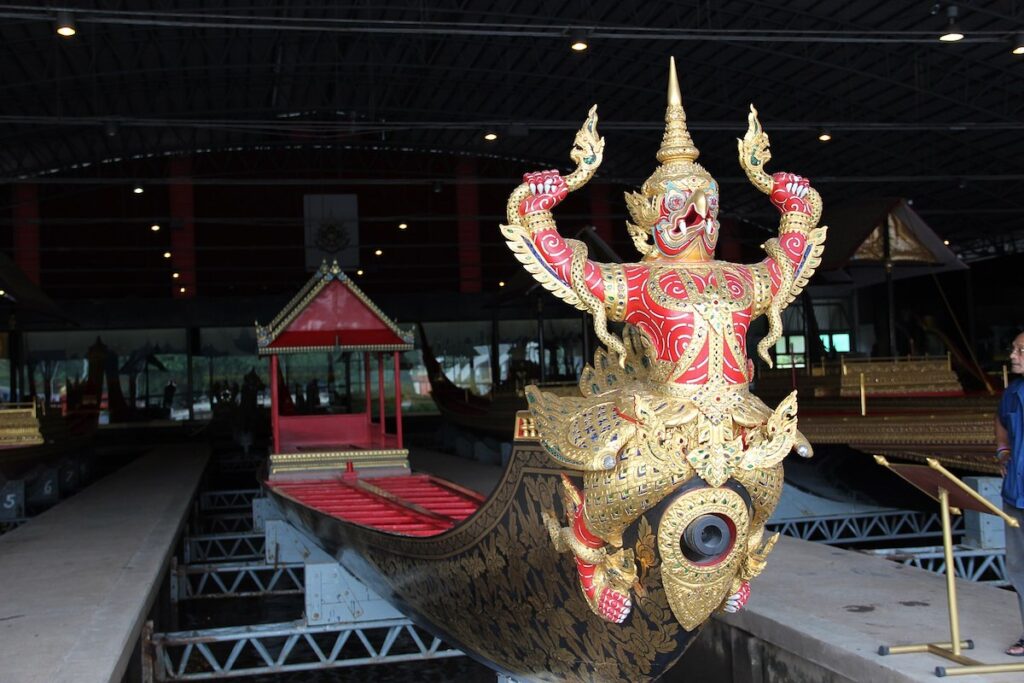
The barge showcases a striking prow with a garuda clutching a naga. Its hull is painted red on the inside and adorned with beautiful floral designs in gold on the black exterior, creating an elegant contrast.
This barge spans 28.58 meters in length, 2.10 meters at the beam width, and has a hull depth of 60 centimeters.
Admission to the museum is reasonably priced, although an additional fee must be paid in order to take photographs and videos. Standard tickets cost 100 baht per person, taking photos costs another 100 baht, and videos another 100 baht.
The museum is situated above a canal, and there are walkways for visitors to explore. It houses eight magnificent royal barges adorned with splendid gold ornaments. However, visitors are not allowed to get too close to them.
How to Get to the Museum
First of all, you’ll have to get to Bangkok. Check out how to travel to the Thai capital from Koh Phangan or Pattaya.
The easiest way to reach the National Museum of Royal Barges is to take a boat along the Chao Phraya River. The closest express boat pier is Pinklao Bridge Pier, but an even easier option is to take the Chao Phraya tourist boat which stops directly outside. Many long-tail boat tours include a stop at the museum on their itineraries, and these can be booked at all major tourist piers.

